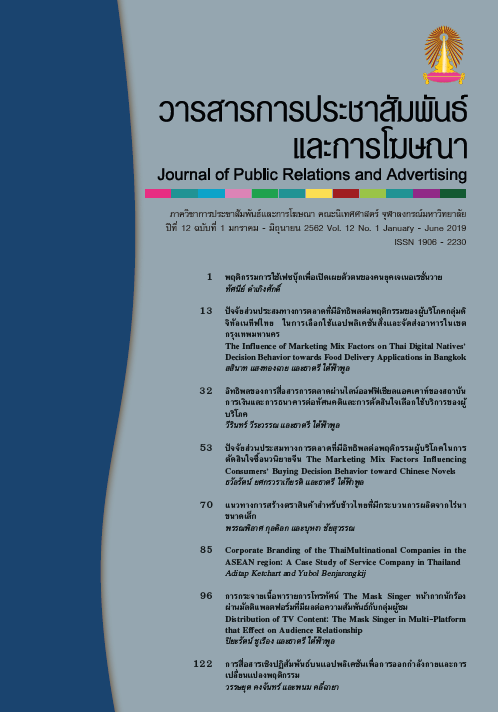Corporate Branding of the Thai Multinational Companies in the ASEAN region: A Case Study of Service Company in Thailand
Main Article Content
Abstract
The purpose of this paper is to explore relevant elements related to corporate branding of Thai multinational companies in the ASEAN region in the form of a case study of a Service Company. Corporate branding helps increase people’s positive perception towards a particular brand, which could increase a company’s ability to compete, especially when the company expands its business to the international level which, in this case study, is the ASEAN region. The selected study area is Thai multinational companies in the service sector whose business has expanded to Singapore. This paper is an on-going research aiming to study the process of corporate branding and relevant factors in Thailand and Singapore since Singapore has been recognized as a business hub of ASEAN and Thailand has also been expanding its operations to this business hub. Data collection method was based on qualitative research method under a purposive approach which conducts in-depth interviews with managerial level staff in the brand communication department of the selected company. The outcome of this paper is to develop a problem-solving strategy, improve corporate branding, and build a corporate branding model. The result, particularly in the service sector, shows that the most important factor from the ‘Receiver’ side is the sender’s ability to fully understand the receiver’s behavior to develop the right message and enhance the corporate brand.
Article Details
References
Budac, C., &Baltador, L. A. (2014). Brand communication challenges in getting young customer engagement. Procedia Economics and Finance 16, 521–525.
Dinnie, K., Melewar, T. C., Seidenfuss, K. U., & Musa, G. (2010). Nation branding and integrated marketing communications: an ASEAN perspective. International Marketing Review, 27(4), 388-403.
Doyle, P. (1990). Building successful brands: the strategic options. Journal of consumer Marketing, 7(2), 5-20.
Foo, C. T., Lowe, A., & Foo, C. T. (2001). Corporate identity strategy: empirical analyses of major ASEAN corporations. Corporate Communications: An International Journal, 6(3), 137-144.
Hu, L., Checchinato, F. (2015). The country of brand communication in the retail setting: An analysis of Italian products in China. Australasian Marketing Journal 23, 325–332.
Juha, P. R. (2009). Brand and branding creating a brand strategy (Master’s thesis, Tampere University of Applied Sciences, Tampere, Finland). Retrieved from https://www.theseus.fi/bitstream/handle/
10024/8472/Ropo.Juha-Pekka.pdf?sequence=2
Kamakura, W. A., & Russell, G. J. (1993).Measuring brand value with scanner data. International journal of Research in Marketing, 10(1), 9-22.
Karl, B., & Jens, L., & Felix, M. (2010).Brand management: A qualitative study on branding in a SME (Doctoral dissertation, Jonkoping University, Jonkoping, Sweden).Retrieved from https://www.diva-portal.org/smash/get/ diva2:322020/FULLTEXT01.pdf
Keller, K. (2013). Strategic brand management: Building, measuring, and managing brand equity. (4th ed.). N.P. Pearson Education, Inc.
Kotler, P., Kartajaya, H., &Huan, H. (2015).Think new ASEAN!. N.P. McGrawHill Education.
Payne, A., Storbacka, K., Frow, P., & Knox, S. (2009). Co-creating brands: Diagnosing and designing the relationship experience. Journal of Business Research, 62(3), 379-389.
Virvilaite, R., Tumasonyte, D., &Sliburyte, L. (2015). The influence of word of mouth communication on brand equity: Receiver perspectives. Procedia - Social and Behavioral Sciences213, 641–646.
Wilkinson, A., &Balmer, J. M. (1996). Corporate and generic identities: lessons from the Co-operative Bank. International Journal of Bank Marketing, 14(4), 22-35.
Wheeler, A. (2013). Designing brand identity. (4th ed.). New Jersey: John Wiley &Sans, Inc.
Yohn, D. L. (2014).What great brands do. San Francisco: Jossey-Bass.


